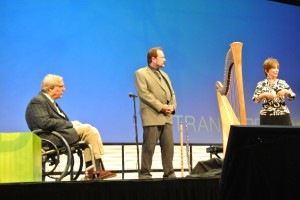This website uses cookies so that we can provide you with the best user experience possible. Cookie information is stored in your browser and performs functions such as recognising you when you return to our website and helping our team to understand which sections of the website you find most interesting and useful.

Susan E. Mazer, Ph.D. Blog
Thoughts and ideas on healthcare
Hi, and welcome to my blog! I'm Susan E. Mazer -- a knowledge expert and thought leader on how the environment of care impacts the patient experience. Topics I write about include safety, satisfaction, hospital noise, nursing, care at the bedside, and much more.
Transform 2013: A Brain Trust of Ideas for Healthcare
September 16, 2013
 This past week my husband Dallas and I spoke at the Mayo Clinic’s Center for Innovation conference, Transform 2013. This was the third year of the conference, attended by over 900 people with many minds and ideas colliding in a wash of TED-style talks.
This past week my husband Dallas and I spoke at the Mayo Clinic’s Center for Innovation conference, Transform 2013. This was the third year of the conference, attended by over 900 people with many minds and ideas colliding in a wash of TED-style talks.
So much came to me that I had to take a step back and just think about what happens when real people get together and talk about what matters. And what happens when all the “talking” demands action.
Thematically, the conference is about transforming our current models of healthcare and care delivery systems into what is being called for. That was the big question of the day: “What are we being asked to do and what are the implications of each solution?”
Technology
It was clear from all the new tools at hand that it is easier to develop the technology than it is to get people to embrace, integrate, and use new tools. Nancy Snyderman, M.D., of NBC, said that new medical students will receive a hand-held ultrasound device rather than the traditional stethoscope.
Electronic medical records and smartphones have opened the doors to virtual doctor consultations and remote monitoring. At some point, we will all be able to have our physiology monitored in real-time where we are standing.
Delivery Systems
The questions regarding the high cost of Emergency Room care were right upfront. David Herman, M.D., was brilliant in claiming that rather than be upset that patients come to the ER for non-emergency room conditions, we should retrain the staff to deal with a broader set of symptoms.
If the people come to the ER because that is the only place they can come, then that is where we should treat them. In other words, the system itself is nonresponsive to those it serves, demanding everyone to adjust to what is clearly not “natural,” or viable for them.
False Science
Snyderman also was passionate about rumor and misinformation turning the clock back on diseases we had eradicated through immunization — whooping cough, measles, rubella, polio, TB. She said that false claims, already discredited, have been met with a passive response from the medical community, putting millions of children at risk.
Remove the Choke Point
No longer should the physician be the single person to govern medical care; rather a team approach using nurse practitioners and other non-medical, well-trained persons should be involved in caring for a patient and their family. It not possible for the physician of today to act as the doctor of old. Although, house calls may return to the fold because seeing patients in their own homes is so much more effective than having patients come into a clinic or office.
Cure Violence
Gary Slutkin, MD, executive director of Cure Violence, described the violence as a contagious disease. People who grow up in violent families at 30% more likely to commit violence. Mob rule: someone(s) start a fight, and it grows as bacteria spreads. In the same way, the disease must be stopped, so violence must be interrupted to break the cycle. The means of violence transmission: witnessing, social learning, trauma, peer pressure. I would add, lack of alternatives, lack of support, hopelessness.
Cure Violence practices, holding violence as a health issue, reduced shootings in Chicago by 67%. Retaliation is a violent relapse, it causes the spread of disease. The culture of this country is about imprisonment and punishment rather than treatment or mediation or addressing foundational issues.
Money
While we continue to struggle with how to pay for everyone to have care, it was clear that there is enough money in the system now if the waste was recovered. The example was a statue of Michaelangelo’s David.
Only 60% of the original block of marble was used to create the statue, with 40% wasted. The waste is similar to the waste in our healthcare system, including insurance administration, procedures that are unneeded, and other inefficiencies.
I am swimming in more information than I can relay. I am stimulated. I am excited. I am even more excited that our presentation focused on our work — on The C.A.R.E. Channel being a solid means of improving the patient experience and transforming our sick system into one that is caring. John Hockenberry from NPR was a brilliant moderator.
I am going to again state that when smart, motivated people get together to discuss what matters, the energy and ideas flow in one direction: Take considered actions to transform the current entrenched system that has started an epidemic of inaccessible, unaffordable care.
Wish you all had been at Transform 2013. Put it on your calendar for next year, September 7-9 in Rochester, MN.










